#emperor charles vi
Text
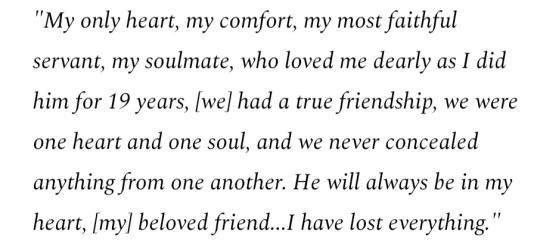
— Emperor Charles VI's diary entry on Count Althann's death
[text: "My only heart, my comfort, my most faithful servant, my soulmate, who loved me dearly as I did him for 19 years, [we] had a true friendship, we were one heart and one soul, and we never concealed anything from one another. He will always be in my heart, [my] beloved friend..I. have lost everything."]
#this is like. incredibly niche.#but also hopefully a quote one can look at without context and still feel emotional damage about#idk. i think about this quote probably at least once a week and then have to stare at it and cry a bit#its just GOD. yknow??????#theres this one paper(which i linked) that i originally read as research for the AU#but i go back to it probably twice a month to reread it bcs im so !!!! abt it#i think its cause charles vi is just not that relevant but is relevant to me so to have this paper abt his personal relationships is very !#its both nice as ref for the au but also very interesting to hear about historical queer relationships/dynamics#the sections about him and his wife are very endearing as well#but god like him and count althann. im literally so invested in this 300 year old relationship#this is obviously from his death which is incredibly depressing and heart wrenching to me#but the other things he wrote about althann in his diary are very sweet to me#they were inseparable to the point of often sleeping in the same bed and charles called him his 'eternal love'#AND ON ALTHANN'S DE WIKIPEDIA PAGE IT LITERALLY CALLS HIM THE EMPEROR'S FAVORITE#anyways literally every part of this quote absolutely destroys me but especially how he refers to althann and then the ending#and its interesting to me bcs apparently his diary entries were usually pretty to the point#but when various people in his as althann died he would write these extremely emotional entries that are so </3#if you have any questions abt their dynamic pls i will talk abt them 🥰🥰 i find it fascinating#theres a book about his diary but its in german and 500 pages and kinda hard to get hold in but maybe one day!!!#also in AU contexts: althann and charles vi would be mark and seb so take that as you will 🤭😭#as i said this is great for ref but also made me sooooo fucking invested in him#i have no idea how to tag this#historical#holy roman empire#emperor charles vi#catie.rambling.txt#historical quotes#habsburg#habsburg monarchy#ah wow if only my german prof could see me now. fucking...habsburg posting. why am i like this
20 notes
·
View notes
Text
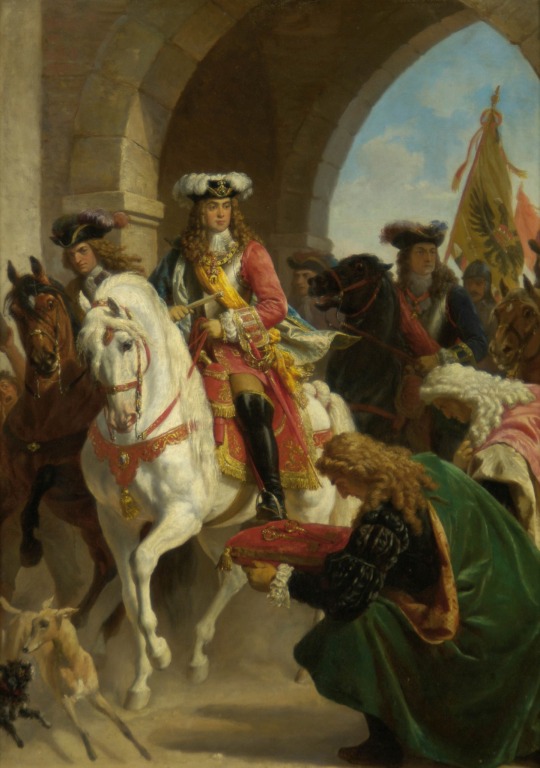
Entry of Charles III in Madrid 1710 by Karl von Blaas
#charles iii#charles vi#holy roman emperor#holy roman empire#habsburg empire#habsburg#habsburg monarchy#austria#spain#madrid#art#karl von blaas#europe#european#history#austrian#spanish#emperor#king#royal#key#keys#city#war of the spanish succession#aristocrat#aristocratic#regal#horses#dogs
49 notes
·
View notes
Text
Since there’s a bit of a hiatus in Dracula Daily right now, I thought I’d take the opportunity to ramble about what I know of vampiric folklore and history in Europe because I cannot contain my infodump and it’s actually really interesting.
Painting it in very broad strokes, the earliest folkloric creature we would recognize as a vampire was acknowledged in Europe in the 1100s and earlier as a human corpse that physically rose from their grave and returned to their former home/village to drink blood. (A 12th-century English text, The Life and Miracles of St. Modwenna, mentions two examples of this type of vampire.) These vampires’ victims did not become vampires as well, but sickened and died, usually from wasting diseases. What caused the original person to become a vampire was variable, but usually involved being, just, an absolute jerk when they were alive, or an increasingly convoluted series of ways in which they attracted bad luck/evil while they lived, after they died, or as they were buried.
This is where the traditions of stuffing a stone in the potential vampire’s mouth, decapitating them and putting the head in the grave between their knees, burying them facedown, cutting off their hands or feet, burying them in a too-small grave, piling stones atop the grave, or burying them with broken legs came from. All of these are regional or historical variations on ways to quite literally prevent the presumed vampire from digging their way out of the grave and causing trouble: an “And stay down there!” maneuver that we’ll see survive into modern pop culture in the form of a stake through the heart.
This was the predominant form of vampirism up until roughly the 1700s: someone nasty in the village died, and after a while, would start reappearing to their family or loved ones at night, slowly draining their lives away as they fell to a wasting disease like tuberculosis or leprosy. Once the villagers caught on, they would exhume the body, find it suspiciously preserved and with blood trickling from its mouth, and then take steps to neutralize the vampiric threat by beheading, staking it through the heart to literally pin it in the grave, stuff a stone in its mouth, or a combination of all three.
(You may have heard of the Venetian mass-burial plague pit an archeological team discovered: one of the skeletons had a brick shoved in her mouth. She was the only body treated in such a way, implying that she was thought to have been a vampire: hypothetically even the vampire that caused this local upswing of the plague.)
A cultural shift happened in the 18th century, however, when the Austro-Hungarian Empire gained territory in Serbia and other portions of the Balkans. Since they were neighbors with the Ottoman Empire, the Austro-Hungarians kept a heavy military presence in these new territories, and the emperor of the time (Charles VI, I believe) asked the occupying forces to collect reports on the local customs and folklore and send them back.
A number of the reports they sent back included vampire stories.
Now, this was the Age of Enlightenment: many countries were pulling away from old superstitions and following the new methods of science. Belief in vampirism was a rural thing, and widespread plague situations had faded enough that they really weren’t relevant anymore and had fallen out of a lot of people’s memory.
But the thing was... science was still new, and this whole vampirism thing sounded just plausible enough to be extremely interesting. The Austro-Hungarians sent all sorts of scientists, doctors, and clergy members to collect and dissect and discuss these stories, and for a short spate of time vampirism was the hot new discussion topic in esoteric circles. And for then and a while after, if you wanted case studies, debates, and just about any reference material on vampires, you knew you’d find it in Austro-Hungary’s library.
Eventually the scientific community all concluded that this vampirism thing was just silly peasants not understanding the process of decay, but the arts crowd -particularly the Sturm und Drang folks in Germany- remained very interested in this exotic new creature steeped in mystery and death. Sturm und Drang translates to “storm and stress” and if I had to describe their style in modern terms, I would say (roughly, and with affection) “a love of edgy tragedies.”
There were a number of poems and works spawned from this flurry of interest, but this Austrian version of the vampire still shared a common theme: more like a revenant than anything else, coming for their loved ones first, and a lot of their horror was tied up in how blasphemous and unChristian their very existence was. Less emphasis was placed on getting rid of the vampire and more was placed on the artistic allure of vengeance from beyond the grave and the vampire’s inherent exotic mysticism and threat.
Stoker, in fact, directly references an example of this in Dracula! On May 5th, when Dracula’s telling the coach driver that he knew they were trying to get Jonathan out of there before he showed up, because he himself drove fast enough to intercept them, one of the other passengers whispers to his friend “Denn die Todten reiten schnell,” which translates roughly to “For the dead ride fast,” a quote from Burger’s Lenore.
Lenore is a poem about a young woman whose fiancé died in the Seven Years’ War (connection with Austro-Hungary). In her despair, she curses god (old-school invitation for vampirism), and the following night, her lover knocks on her door to take her on horseback to their marriage bed (vampires attack their loved ones first). He takes her on an increasingly terrifying ride through the night, prompting the above quote, which ends in a graveyard, where he is revealed to be a skeleton and Lenore dies.
Lenore was written in 1774, and although William is not technically a vampire, the poem is an example of the old-school vampire type. The vampire is a physical reanimated corpse that does not create more of its kind, but causes the people around them to die/waste away, and attacks their loved ones before anyone else. The transition to what we finally would recognize as a modern vampire started with Carmilla and was solidified in Dracula.
Written in 1872, Carmilla is a blending of both old and modern vampiric tropes. It uses the then-expected setting of the Austrian Empire, all of the titular vampire’s victims wasted away and died rather than rising as vampires themselves, and Carmilla’s coffin was filled with blood when she was unearthed. However, she was also able to shapeshift into a cat and walk through walls -no longer just a revenant- and she could walk around during the day without harm. She also does not target the people she knew and loved in life first: Carmilla is a vampire centuries old and her current victims are chosen indiscriminately. The vampire as a folkloric creature was evolving.
And, side note, while it was used partially as a narrative device to show how evil and unnatural Carmilla was, she was also gay. Gay as fuck. People who lost their shit at
“Then the Count turned, after looking at my face attentively, and said in a soft whisper: ‘Yes, I too can love’”
will go absolutely mental at Laura going
“It was like the ardour of a lover; it embarrassed me; it was hateful and yet overpowering; and with gloating eyes she drew me to her, and her hot lips travelled along my cheek in kisses; and she would whisper, almost in sobs, ‘You are mine, you shall be mine, and you and I are one for ever.’"
Anyway. Queerness is baked into the concept of the modern vampire from the very beginning, what of it.
With Carmilla as the springboard, though, Stoker was free to finally create Dracula, which was essentially the turning point between modern and archaic vampire depictions. He took all of the old stuff and reworked, revamped (heh), or added to it to get the foundation of the stereotypical vampire we know today.
He shifted the geographic vampire hotspot further over from Austria-Hungary, landing it in neighboring Transylvania. Dracula’s victims weaken and die and seem to be inflicted with a strange wasting disease, but can also turn into vampires themselves. Driving a stake through his heart and cutting off his head is no longer an attempt to pin him in his grave and keep him from rising, but merely to destroy him. He was dead, yes, and very unholy, but he also had powers beyond merely being a risen corpse, and his power set became the standard for future vampire media.
Hence, Dracula becomes the foundation for the modern concept of a vampire, which is why pop culture usually treats it as the beginning point of vampirism in general.
811 notes
·
View notes
Photo

Medieval Brittany, 9th-14th century
« Atlas historique de la France », Les Arènes, 2020
by cartesdhistoire
The Brittany peninsula experienced an influx of people in the 6th century, including invaders from England. An independent Brittany emerged amidst the fragmentation of the Carolingian Empire and Viking raids. Nominoë, appointed representative of the emperor, established his sovereignty after defeating Charles the Bald at the Battle of Ballon in 845. His son, Erispoë, became king of Brittany in 851. Armorica became a duchy in 939 but remained de facto autonomous, under the influence of the Plantagenets (1148-1203) and then the Capetians (1203-1341). Brittany became a duchy-peerage of the Kingdom of France in 1239. In 1491, Duchess Anne married King Charles VIII of France, initiating a process that culminated in the Edict of Union definitively attaching Brittany to the kingdom in 1532.
Breton is spoken west of a Plouha-Loudéac-La Roche-Bernard-Batz line, which has remained relatively stable over time. From the 9th century, the entire eastern area of Brittany spoke Gallo, an Oïl dialect related to Norman and Angevin. This region includes Dol, the seat of the archbishopric until 1199, and cities such as Nantes and Rennes, where the States of Brittany convened from 1352.
The administrative language of Brittany was not Breton but Latin. French began to appear in the 1240s and became widely used between 1250 and 1280, a trend observed in other French regions during the same period. From the mid-13th century, counts of Champagne favored French for their feudal affairs. The Count of Blois definitively abandoned Latin in favor of French from 1267. The Dukes of Burgundy extensively used the vernacular language during the second half of the 13th century, with French becoming their exclusive language from Duke Eudes (1315-1349). Paradoxically, French only became the dominant language of the Chancellery of the kings of France later, under Philip VI (1328-1350).
77 notes
·
View notes
Text

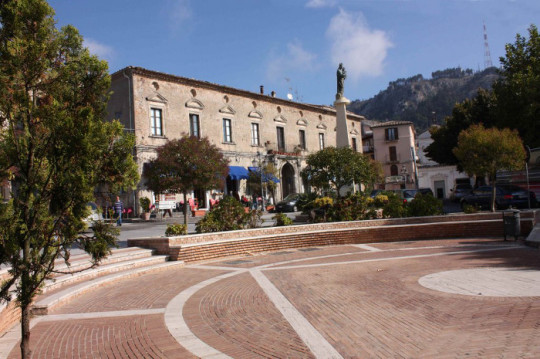


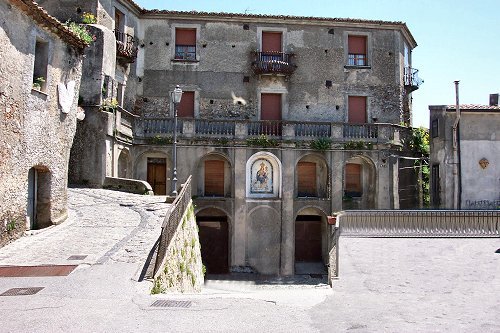
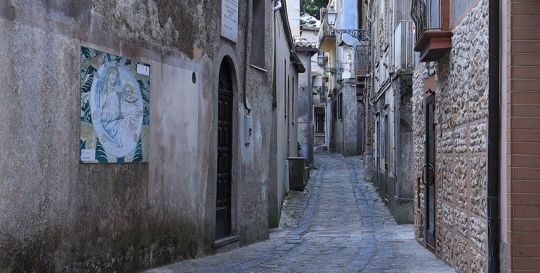



Tiriolo, Calabria, Italy
The houses in the historic center of Tiriolo are perched like in a nativity scene, making up the old part of the town, while the new buildings extend along the foot of the hill, nestled between the mountains and the valleys.
Legend traces the origins of the settlement of Tiriolo back to Hellenic people six centuries before the Trojan War or even identifies it with the mythical Scherìa, the happy homeland of the Homeric people of the Phaeacians. Archaeological findings, however, support the hypothesis of the existence of a dwelling nucleus since the Neolithic, as revealed by finds such as polished axes, rudimentary chisels and obsidian scrapers. The subsequent Roman presence finds its most relevant testimony in the famous bronze tablet engraved with a text concerning the Senatus Consultum de Bacchanalibus, a decree of the second century AC, with which the Roman senate prohibited the Bacchanalia, orgiastic rites in which even the elites participated and therefore considers it the context of possible conspiracies against the state. The artefact, found in 1640, is now in the Kunsthistorisches Museum in Vienna, offered in 1727 as a tribute to the Emperor Charles VI of Habsburg.
Follow us on Instagram, @calabria_mediterranea

#tiriolo#calabria#italy#italia#south italy#southern italy#mediterranean#italian#europe#landscape#italian landscape#folk costume#folk clothing#traditional clothing#folklore#picking flowers#flowers#italian women#italian girls#nature#nature photography#sea#seascape#mediterranean sea#ionian sea#beautiful view#beautiful views#mountains#mountainscape#architecture
41 notes
·
View notes
Text
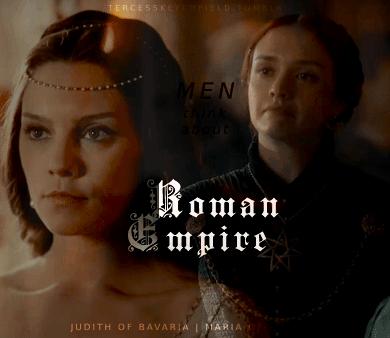
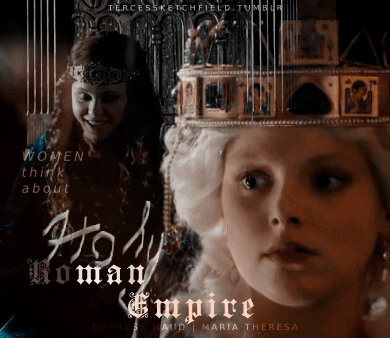
MEN THINK ABOUT ROMAN EMPIRE. WOMEN THINK ABOUT HOLY ROMAN EMPIRE
JUDITH OF BAVARIA (797-843) — Daughter of Count Welf I of Bavaria, Judith was a Carolingian Empress as the second wife of Louis I the Pious. Mother of Gisela and Charles the Bald, she foght for both her own influence at court and for the succession of her son over the claims of his elder half-brothers, the sons of Louis I from his first marriage. Charles became the Emperor in 875, after the death of Louis II, his nephew and a son of his half-brother Lothair / fancast: Annabel Scholey
MARIA OF AUSTRIA (1528-1603) — Daughter of Charles V, Holy Roman Emperor, and Isabella of Portugal. She served as Regent of Spain both jointly with her husband, Maximilian (before their accession to the imperial throne), and in person, for her father, and brother, Philip II. Her children include two Holy Roman Emperors, Rudolf II and Matthias, over whom she held great influence, and queens consorts of Spain, and France / fancast: Olivia Cooke
EMPRESS MAUD (1102-1167) — Daughter of Henry I of England and Matilda of Scotland. Her first marriage to the Holy Roman Emperor, Henry V, gave her the title under which she came down into history, and was a source of great pride to Maud. Rightful heiress of Henry I, she confronted her cousin, King Stephen, in the civil war, known as the Anarchy, fighting ferociously for her rights. She failed in this for herself but won for her son Henry, who became king and established the Plantagenet dynasty in England / cast: Alison Pill in The Pillars of the Earth (2010)
MARIA THERESA (1717-1780) — She succeded her father Charles VI as the ruler of Habsburg monarchy in 1740, and devoutedly defended it against its enemies in the War of Austrian Succession and the Seven Year's War. Wife of the Holy Roman Emperor, Francis I, she was a forceful personality and a competent ruler herself, reigning first in her own right, and later, jointly with her son Empreror Joseph II. Her children include two Holy Romam Emperors (Joseph II and Leopold II), queens consorts of Naples ans Sicily, and France / cast: Marie-Luise Stockinger in Maria Theresia (2017)
#historyedit#judith of bavaria#maria of austria#empress maud#empress matilda#maria theresa#maria theresia#perioddramaedit#history#women in history#perioddramasource#onlyperioddramas#tusereliza#userbennet#usermina#weloveperioddrama#cortegiania#perioddramagif#gifshistorical#my edit#*i have literally zero idea what is this lmao* but i really like it idk
113 notes
·
View notes
Text
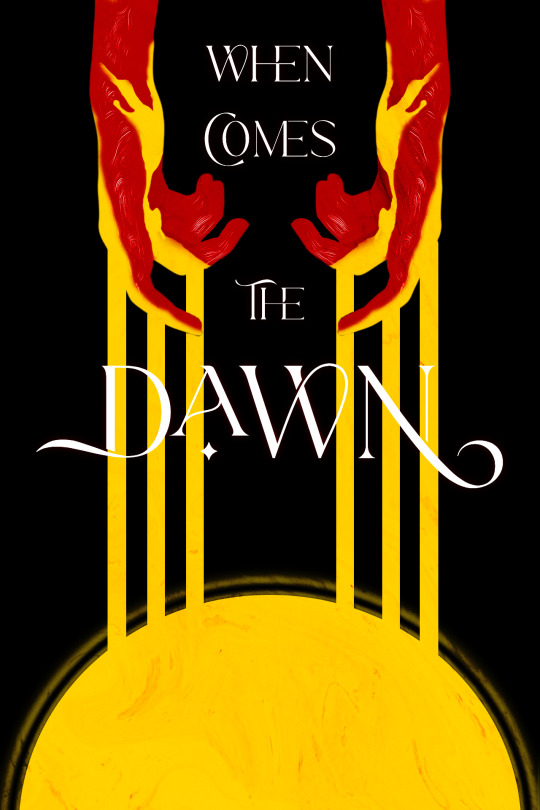

WHEN COMES THE DAWN | a wip reintroduction
↳ General Info
genre: new adult fantasy court intrigue
pov: 3rd person dual pov
stage: re-planning/drafting
started: 9.3.2023
projected word count: ~90k
Book 1 of 2
FENICE VI AETIER, a portent of ill omens and the estranged daughter of the Vasilier, ignites a dangerous succession game between her and her half-siblings, where losing means death and winning means an empire.
The end of the Hes-Aei war brings with it a chance to prove her worth to her father. The challenge is simple: bring him the head of the deposed king of Hesperia, and Fenice will be granted an Ascension, marking her as a legitimate contender for the throne. But finding the defeated king in his own lands would prove to be harder than Fenice imagined— especially when the remnants of her father’s last war starts rearing its head.
↳ The King's Game
A system decreed by the first emperor of Aetier that whoever among his children is the most skillful shall inherit his crown. But time has warped the rules of inheritance dramatically. The only way to survive is to win, and the only way to win is to be the last one standing.
↳ The Major Players
FENICE VI AETIER ◇ the contender | The worst-kept secret of the imperial family, and now an unknown factor in the politics of the Aetier court. The King's Game is her chance to stake her place in history. What she seeks is glory eternal, and she will do whatever it takes to get it.
NIKEPHOROS DEOMINOS ◇ the serpent | The prince of a conquered kingdom, now nothing more than a war prize. He muffles his anger with practiced smiles, playing the game of deception even as it tears him apart at the seams. He will lose either way, all that matters is deciding what he can bear losing.
CHARLES VI AETIER ◇ the favorite | The Vasilier's son with the world at the palm of his hand. The lonely prince with a gentle heart and a willingness to turn a blind eye to the cracks in his perfect family.
SOLA EIDOS ◇ the hound | A man of of unknown origin and a shadowed past, his real name buried beneath the soil of his homeland. He is an information broker, a spy, an assassin-- if you pay the right price. The one thing that can never be bought is his loyalty, a worthy master is hard to find.
SARTORE VITAE ◇ the enigma | An eccentric noble from Leohnthal who can charm his way to a seat at every table. Great with words and even better at half-truths, he is a man that sheds faces as easily as a snake sheds its skin.
Find more WCTD content with the series tag #series.wctd and keep an eye out for monthly progress updates with #wctd-monthly -- the first post coming soon!
Tagging: @sourrcandy @helioselene @seasteading @writinglyra @socialmediasocrates @serpentarii @asa-writes-stuff @cheshawrites @atelierwriting
#wtwcommunity#writeblrgarden#writeblr#wip intro#series.wctd#collection.my edits#collection.my projects
136 notes
·
View notes
Photo

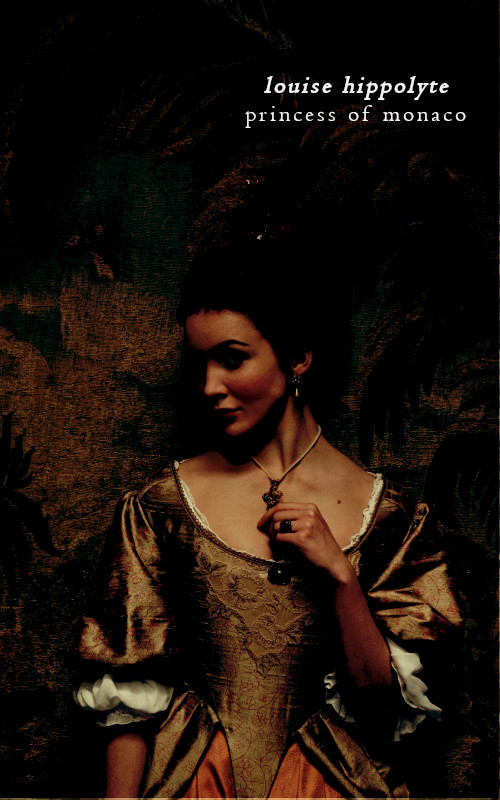
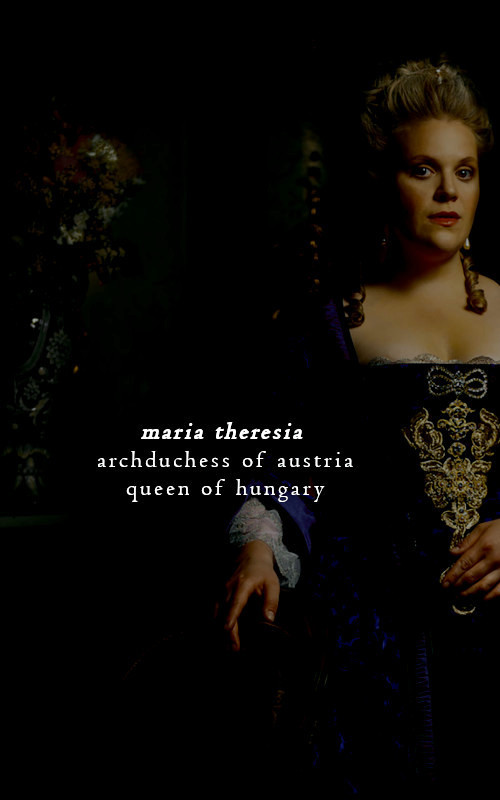

Favorite list of royal women | Regnant queens (who crowed herself queen without her husbands)
Been a queen regnant is not always easy specially when you are married but mor common than one would think. Here four of my favorite queen that were married and despite what society, and often the husband himself, thought decided that her lands by heritage or conquest were only hers to rule.
i. [1081-1116] Called The Reckless, Urraca was one of the most powerful reigning Queens of her time having inherithed the kingdom of León. Upon the death of her first husband she was convinced to marry Alfonso of Aragon the most successful warrior king of the Iberian Peninsula. It went horribly wrong. Personalities clashed and Alfonso emprisoned Urraca at one point. With Galicia rebelling and the Almoravides menace the spouses still went to war againts each other. Finally they separate and while Urraca still has a long way ahead and could keep most of her lands for herself.
ii. [1697-1731] Louise Hyppolite was at her time of birth the last Grimaldi. Monaco was under French control and it was decided that man from the French King family will be Louise’s husband and rule along with her. She was married and had to leave her land with her husband. Described as shy and submissive she did not enjoy her time at Versailles. When her father was ill she came back alone to Monaco and when he died she crowned herself Princess of Monaco with the people enthusiastic support naming her firstborn heir. There is no much her husband could do and though she ruled fr a short time she did it as the sole Princess.
iii. [1717-1780] Maria Theresia’s father Emperor Charles VI of the Roman Empire, did not prepared her to rule as he was convinced that her husband would rule for her. However, she had other plans and when her father died Maria Theresa, a 23 years old set to stablish her right as a moanrch against Prussia and most of Europe. She manage to gain ruling experience and be a monarch for 40 years. Though she deeply loved her husband she did not let him rule in her name and even refused to kneel in front of him when he was elected Holy Roman Emperor as she was of highest ruler. She was Sovereign of Hungary and Bohemia and Archduchess of Austria on her own right her husband being the consort.
iv. [1583-1663] Njinga was Queen of Ndongo after her father and brother. At the time with the Portuguese slave trade Njinga became a symbol of resistance to the Europeans. In order to gain power in the center of the region she married an Imbangala leader and learned the techniques and strategies of his people. However when she set to conquer the kingdom of Matamba and ruled there as the Queen as Matamba had tradition of female rulers. As she gained influence she was recognized as one of the great queens of the region at the time.
#historical women#women in history#maria theresia#njinga of ndongo and matamba#urraca of leon#louise hyppolite of monaco#maria theresa of austria#history
69 notes
·
View notes
Text
Marianne's Past


I went and read the Marianne vi Britannia chapter from Mamoru Iwasa's "Knights of the Round" short story anthology that was released as a bonus volume to his Code Geass R2 novel series.

I am 80% sure that this image that is often seen floating around online was made to promote this specific short story (or maybe accompany a serialized release?), but the illustration itself is not included in the tankobon release.
I'll provide summary of the short here here, but please be aware I am reading with machine TL and there may be errors even despite the best of my double-checking. If you want these details for, idk, academic reasons please go to the source text first!
Anyway this story rules, here it is. Italics mark direct quotes.
We start off strong with Charles thinking "I had no reservations about wasting my own life." Standing in the middle of a battlefield, he laments that Britannia is a dying country structured around a bloodthirsty elite. No dreams, no hope.
"Born into such a world, why would you desperately try and such a small thing as your own life?" he thinks, but then Marianne's voice cuts through to him. Marianne waltzes into the room where Charles stands surrounded by soldiers pointing guns at him. Injured, in her bloodstained white uniform, she fights her way through to him with unbelievable competence and elegance. She beheads all the men as the narration describes the beautiful glisten of her sword and the flow of her hair.
Marianne, the Knight of Six at this point, sheathes her sword and bends the knee before Charles, in the middle of corpses and with both of them splattered over and over in blood.
"I sincerely apologize for any trouble I've caused you by being late," she says.
Marianne tells Charles to evacuate, but he remains stoic and only looks at her arm, which is rendered unmoving by her injury.
"That wound. You've killed, Knight of Six. You've killed the Empire's most powerful knight, the Knight of One."
Only he would have been able to hurt her this badly, Charles reasons.
The Knight of One turns out to be the person who staged this rebellion in the first place and Marianne did indeed kill him before coming to find Charles.
We learn that Charles' reign is being questioned by conservatives because he was such a distant candidate for the throne originally and ascended mostly due to the past emperor's insistence.
"There is external trouble, and the internal anxieties are becoming more and more serious. This a country on the verge of ruin. Don't you agree? Knight of Six," says Charles who is feeling talkative.
Marianne disagrees. After all, she's here and so is Waldstein, still Knight of Five at that time. They won't let it come to that.
"Then, will you come to my side, Marianne?" It's the first time he's ever called her by name and not title and she blushes.
(Here we briefly learn Marianne had a normal military career before being promoted to the Knights of the Round.)
Before she can ask what he means, Marianne realizes the truth for herself and blushes harder. Through a whirlwind of emotion she finds unwavering determination within herself.
"I humbly accept your offer."
He looks at her with eyes that seem almost sad.
"You might regret it."
The narration suggests he may be trying to make sure she knows he isn't going to force her.
Marianne denies the possibility. She won't come to regret this, because as long as she's by his side she will prevent all causes for regret from occurring.
"So you're saying your own happiness depends solely on yourself." Charles finally smiles faintly. "You're bragging, Marianne. Show humility."
"Yes, Your Majesty."
Amidst the smell of gunpowder and blood, a man's hand was slowly held out. The girl's hand rested on top of his, a little awkwardly, but with a certain intent.
We then learn that this rebellion, the Blood Crest Incident, took place May 6th 1997 so a bit less than three years before Lelouch is born. Most of the Knights of Rounds were murdered in it or executed for being complicit.
The narration spends some time discussing whether Charles should be seen as a good or bad ruler, coming out conflicted.
Arguments for being a good ruler: Britannia was on the verge of collapsing and being divided between the other two super-powers before Charles revived it. Arguments for being a bad ruler: ... well, about that bloody conquest though.
Fun side details: leader of Charles' political opponents was his uncle the Archduke Louis. Anyway, we skip forward 5 years, and the civil war and unrest has now ended.
Marianne is the 5th Empress. We are treated to her in the Aries villa garden, sparring with three young teen girls from the military academy: Cornelia, Beatrice and Nonette.
None of the girls stand a chance and Marianne harshly critiques their swordplay, but she ends with saying they're getting better and she's looking forward to the next vacation. She winks at them.
We briefly learn that Cornelia's mom comes from a pretty traditional family and wanted her to be more of a palace lady but Cornelia's own wish was to enter the military. Whenever she has time off from school she comes to the Aries villa to let Marianne train her.
As Marianne talks to the girls about their training later, a small kid looks out from under her skirt.
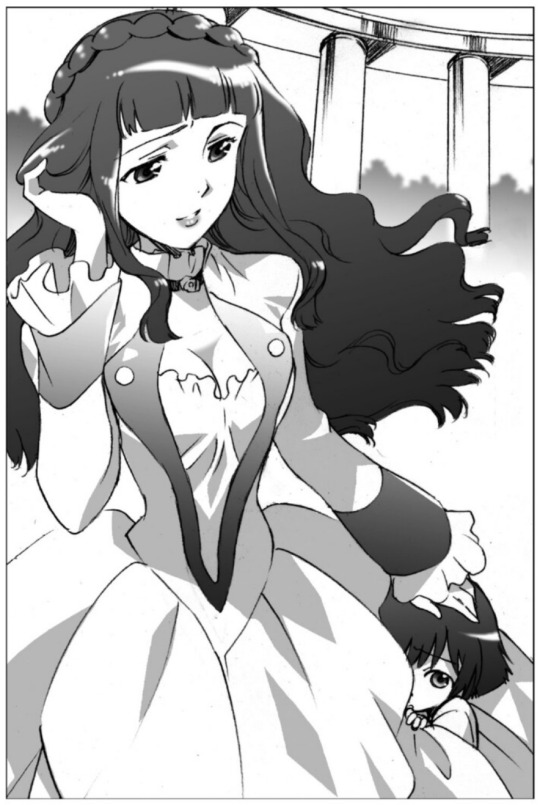
Barely 3year old Lelouch enters the scene! He's entered a shy phase and has to be coaxed to say hi to Cornelia. (But he does do a proper bow and greets her as 'elder sister'!)
Cornelia mentions that Lelouch's shy phase is the total opposite of Euphy who is currently following everyone around 24/7 and being SUPER social no matter the person.
Then, Bismarck comes in. He is holding a crying baby Nunnally and is locked in a vicious circle of trying to get her to stop crying by smiling but having a smile that is too scary to comfort the poor baby. Cornelia laughs at the Knight of One in such a predicament.
Of course, Marianne was the one who forced him to hold the baby despite all his protest that he, who's not even married, would be shit at it. She appears remorseless.
Marianne says she was trying to teach him the stress of a mother who has some maternity nerves due to taking care of two kids, and he's just like. Ma'am the nannies take care of your kids, there is no way you are that exhausted. (He does not say this out loud.)
Beatrice, who has many younger siblings, saves Bismarck and calms down baby Nunnally. Nonette, who likes throwing babies in the air, is banned from approaching the bappy.
Marianne tells the girls to watch the kids for a bit and walks off to talk with Bismarck about serious matters. There's a cute paragraph about the girls helping Lelouch do his first tumble roll and him being really happy about it.
Bismarck muses that not too long ago it would have been unthinkable for there to be the laughter of children in the palace. Marianne teases him that continuing to ensure this is possible is why he's here, isn't he?
Bismarck is Knight of One and also the ONLY Knight of Rounds at this moment. Marianne left the Knights after becoming Empress and the others all died due to the Blood Crest Incident. No new ones have been appointed since.
Bismarck tells Marianne that he thinks she is more suitable to be Knight of One than him.
Marianne doesn't entertain the thought. Bismarck wants more Knights appointed but Marianne says that Charles was ambivalent to the suggestion, being not really concerned about his own safety. Also there are no promising candidates right now.
Anyway, the main reason Bismarck dropped by is because the current Chinese Emperor passed away. This unrest and uncertainty has Charles setting his sides on border expansion and conquering more territory.
Marianne grows pensive. Is Charles good or evil? She's wondered often. We launch into a flashback:

“Your Majesty--do you aspire to be a conqueror?”
Marianne asked him one day, and Charles, laughed happily, which was unusual.
"Hmm...Is that what you see, Marianne?"
"Yes. At least in my eyes."
"Conqueror, huh? If that's what you want, that's not bad either," Charles muttered, an even more amused smile appearing on his handsome face.
When Marianne heard this, her expression turned grim.
“If you are serious about such things, I will refuse to touch His Majesty from now on. Please do not enter my sleeping quarters again. I will immediately decapitate myself.
"I thought you'd say that. But, Marianne, there's one thing you forgot to mention. In that case, you would only kill yourself after beheading this emperor, right? ”
......
"Is it untrue………?"
"Mhm."
"You are a person who never compromises on yourself. Just like me. Therefore, your wings are something that even this emperor cannot control, and the way you flap your wings nobly captures his heart." Marianne couldn't help but smile crookedly as the truth was whispered to her from an unexpected source. Seeing this, Charles also laughed.
"Marianne. My desire is not to conquer the world. It is to strip away the lies of the world. In the process, I hope for the world. I will rid the world of lies. That is my oath. ...But let me promise you this, Marianne. The inside of your heart that you never show to others. That emptiness that cannot be wiped away. Even that, I will make up for it.”
Marianne's expression returned to normal and she fell silent.
Then she said, "If His Majesty truly thinks so, I will create a 'vessel' for His Majesty. His oath, the power to approach it. The path - an army strong enough to conquer the world."
The emperor laughed loudly this time.
"That means you're joining forces with the worst sinner in history, Marianne. Your children and grandchildren will continue to be accused of being witches who assisted the most evil king in the world."
Marianne smiled too.
"Of course, I am prepared. Your Majesty does remember what I am called, right?"
"The Flash. It sounds good, but a flashing light burns people's eyes out. Moreover, your light is by no means the halo of a saint..."
"A bloody hero's death. I have never wielded a sword for anyone other than myself.
"Even when you protected me... that's why I wanted you. Would you like to see the world together, Marianne?''
“Even if it costs me my life.”
Since then she knew.
This person was planning to spread his wings even bigger someday.
Britannia, a continental country. However, this person cannot fit into such a small container. He has to involve many countries and puts the world under its control. Even if he was called a tyrant, or the king of Hades with the sickle of death. Moreover, his motivation was never ambition. Nor was it vigor. Instead it was because of the tears of blood that this person shed when he was young. To fulfill the vow he made. In that case, what she can do after deciding to walk with this person is--
With this cut-off phrase we go back to the present.
In the evening of her meeting with Bismarck, Marianne calls the three girls to meet her. She appears wearing her old Knights of Round uniform and tells them she won't be able to accompany them in their training for a while, so they should use this opportunity to come at her like they mean it because she also won't hold back. For the first time in their sparring, she is dual wielding which was her preferred mode of combat during her active days.
We skip the combat and go right to Marianne coming back out to talk to Bismarck. He remarks that this was quick. The girls stood no chance, though Beatrice held out slightly longer than the others. Marianne asserts that a Knight of the Emperor needs no naivety or kindness so she tried to knock that out of the girls here. She expects they will be changing bit by bit from here on out. Marianne and Bismarck begin to leave for the capital.
Marianne: "Then let's go, Bismarck. To help the king commit the worst crime in history."
Bismarck: "And so it's the return of the empress general."
As they are about to leave a nanny and a crying baby Lelouch stop them. Lelouch had a scary dream during nap time and needed to see his mommy. He had a dream his mother was going very far away.
Marianne tells Lelouch that she isn't going anywhere. But her eyes are cold, as if she was looking at a wooden dummy. Bismarck has seen this expression on her many times before - it's the face she makes before cutting somebody down on the battlefield.

Bismarck is so used to this expression signifying killing intent that his body almost intuitively moves to protect Lelouch - but Marianne just hugs him.
"Lelouch and Nunnally are mother's treasures. I will always be with them and protect them. Forever and ever."
In her heart, Marianne adds: 'However, this is only true so long as you do not stand in the way of he and I.' She suddenly finds baby Nunnally staring at her - she smiles, and Nunnally suddenly trembles as if frightened.
All she can do is stare at her mother's smiling face.
Six months later the Britannian Empire starts its massive expansion campaign, with Marianne The Flash serving as Charles' greatest support.
#code geass#marianne vi britannia#charles zi britannia#het powercouple of all time they make me insane#bismarck waldstein#is also here
45 notes
·
View notes
Note
can u give me a guide to the six idiots :33 like maybe with a picture of them n their names n who they play in the Big Three shows :33 pwetty peesse :33
UM YES!?
ok, you saw me earlier trying to format all the images so it's gonna be mostly my (ehhhh) descriptions of the characters and you gotta guess what they look like 😈
Ben Willbond

Yonderland:
Elder Vex (above): the one who says Deb-beh and has the coziest looking outfit I NEED IT RN PLZ and the Tom Cardy- esque hair and earring
Nick: the stick. Grumpy all the time cuz he's a stick >:(. Is also a portal between dimensions but whatevs
Horrible Histories
Mike Peabody :historical news reporter that wishes he were anywhere but here rn
King Henry, Alexander the Great: SkINy MaNdRiA, excellent hair, sniffed a guy
Ghosts
The captain: AKA James, makes a lotta noises, if you ever hear me going weeeahhhhhuuuueeeaaaaaahhhh, I'm referencing him, the gay one<3
Martha Howe-Douglas!

Yonderland!!
Debbie.
Debbie's evil twin sister (bossy boobs)
I just googled it: Rita, the Negatus simp AKA us, the demon that looks like how female animals are protrayed in Barbie movies
Horrible Histories!!!
Boudica (look up the song, it's rlly good), Cleopatra, every female historical figure
Pirate lady....<33333
Ghosts!
Lady Button (present day): Old disgruntled lady that pouts all the time and falls out of windows
Lady Button (flashback)
Mathew Baynton!!!

Yonderland!!!
Oracle: weird blue blob guy, Nigel, Darling
Nanny la roo: NUM NUMS!!!! - nanny that is also a kangaroo
Admiral Anous: Voldemort mf I hate him bc he hates Negatus>:(
Elder Choop: Croissant hair mf, says, "IDK WHY DON'T WE ASK UR MUM??"
Le Fox: French
THE BIRRDDDDD: AKA Thomas Payne, Batman but cooler
Oh yeah, and Elf: the elf shaped one, full name: Grintallin Gobscrew Crotell Fashanu F’naw Goplatz Holla-Holla, has multiple wives apparently and is in debt to the mob
Horible Histories (look all of them up, they are all hot)
Dick Turpin: play the song >:333, shot not one but two men dead!
D.I. Bones: the whakkus bonkkused
King Charles II: absolute party-er
Ghosts
Thomas Thorne, shot, dead! Absolute poetic simp for Allison, drowned himself in the lake ;( -cannot drown-
Jim Howik!!!

Yonderland
Elder Pressley: looks like Elvis, eats christmas tree ornaments
Crone: A sLaPper *wink wink*, has apparently gotten with everyone, goes eeeerrrrrrrrrrr all the time- sounds like a doorhinge, she is amazing
Neil: lhe most normal of the demons probably
Horrible Histories
A SHOUTY MAN!!! :does all the infomercials, will try to sell you piss
King George VI (above) : "oh yesss, dad's dead, I'm king..."
King Richard III: a sweet little guy<3 -according to the song, get's attacked by whasp
Ghosts
Pat Butcher: Greatest DJ in the AAARRREEEEEUHHHHH, killed by a child, AKA Pete in the American version
Larry Rickard

Yonderland
Detective Mounteback: very dumb detective with very large hat
Elder Ho Tan: trans Icon, doesn't like loud noises, absolute baby<3
Sue: above, the lady with the gun from the episode I showed you
Horrible Histories
Bob Hale: weather report, needs a hellicopter and a nice cup of tea, basically Bill Wurtz
Lol knight with shit on head, Aztec guy, George III friend who slays so hard; "ConGRatu-VerY-LaTiOns your... *MAgEsTy*"
Ghosts
Humphrey: keeps getting left on roofs and shelves, does NOT know French smh
Robin: 5,000 yo ghosts, once saw a cool butterfly, KNOWS FRENCH! Got stuck by lightning and now he can turn on lights
and finally... the moment you've been waiting for...
Simon Farnaby!!!

Yonderland!!!
Negatus<333: Silly guy try to take over Yonderland but is just a lil guy, has an evil lair, uses The Font of Orris (cauldron thing that lets you see everything) as a hot tub, get's bullied by all the other overlords, wears pjs with houses on them.
Elder Flowers!!!: Long hair and lack of shirt, vegetarian hippie of the group, wants his clothes to be veGONE, "all you need is love, brothers... oh, and food"
Horrible Histories
Emperor Caligula: the wakkus bonkkus guy
Marcus Licinius Crassus: Knockoff Bassline Junkie song
Ghosts:
Jullian!!!: Died conducting an affair with his secretary!!!, is eternally sorta drunk, does the hand thing, only ghost that can interact with stuff, makes silly EEERREREEEEE noise when he's trying to move something, his name is Trevor in the American version, sad when there's no porn on da TV ;(, has no pants BTW
Thanks for coming to my TEDTALK!!!
Lemme know if I missed anything!

30 notes
·
View notes
Text
Aahhhh you know what I just realized? When I was in Vienna, we went to a Vivaldi concert in Karlskirche. So my guy Charles VI commissioned this church, right? And he actually really loved Vivaldi's music and talked to him a lot, and even gave him the title of knight! And Vivaldi also dedicated his Opus 9 to Charles VI. It's such a shame bcs Charles VI invited him to Vienna and was going to be his patron but he died soon after :(( But Vivaldi was buried near Karlskirche and so because of that, they perform a lot of his work at the church!!
But its really cool to me that I got to listen to Charles VI's (probably) favorite composer in the church that he commissioned, it feels special :)
(Okay ig "obscure history fact time with Catie" is a daily occurrence atp)
#Just the amnt of historical connection is crazy....#WISH I KNEW ALL THIS WHEN I WAS THERE#I love the relationship of composers w royalty/rich people back then#Like imagine the emperor is just mailing you like 'yo that was an absolute banger you just dropped'#And now when I listen to vivaldi I'm just like wow...I bet Charles VI was into thus#catie.rambling.txt
13 notes
·
View notes
Text
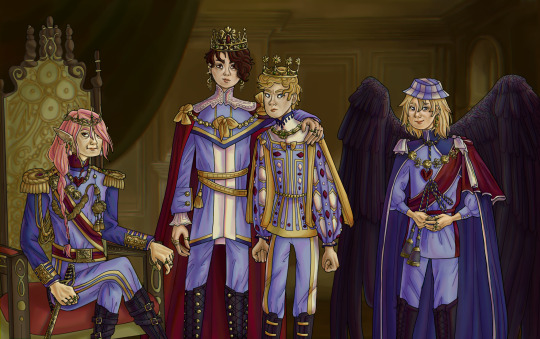
[The royal family of the Antarctic Empire as pictured above, left to right: General Technoblade, the heir apparent Wilbur Soot-Craft, the young Prince Theseus, and his majesty Emperor Philza Craft.]
After months of working on this on and off, I have finished this piece. Since this has taken up so much of my life, I'll put my ranting and extra details under the cut.
So, references. Phil is mostly based on this portrait of King George VI, little details I added were crows on the chain around his shoulders and the emblem of the hardcore heart. He was originally supposed to have a crown, but it just didn't feel like Philza without the bucket hat :)


Meanwhile, Tommy is based on King Henry VIII. This is a jump back in time periods, but I didn't want all four of them to be in the same sort of outfits. Compared to the other SBI members, Tommy's only jewelry is emerald earrings and necklace. He also has suns on his crown because... sunshine


Wilbur is based on Charles I, another leap back in time periods haha. I struggled the most coming up with his outfit, but I liked the looser look on him. And he has a cape :D he matches with Phil since he's the heir apparent.


Techno, the outlier, is based on this painting of a soldier. I picked this reference for the sole reason that I liked the uniform lol. In this AU Techno was the heir to the throne before he passed on the right to Wilbur and chose to lead the Antarctic army. A detail I lm fond of is that on the scabbard of his sword you can see Ariadne with a ball of thread leading into a labyrinth. Because, y'know, Theseus :D

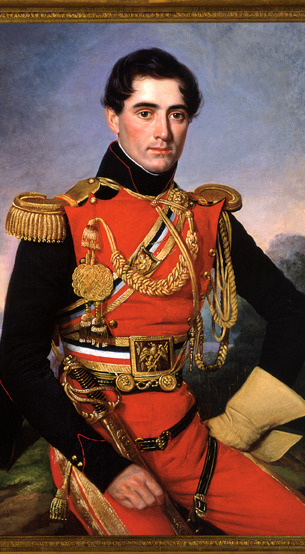
In the end, I'm not at all knowledgeable about historical clothing or who would wear what, I mostly chose things for The Aesthetic lol, but hopefully the time and effort put into this piece is apparent : )
#sleepy bois inc#sleepy bois fanart#tommyinnit#tommyinnit fanart#wilbur soot#wilbur soot fanart#technoblade#technoblade fanart#philza#philza fanart#antarctic empire#fanart#mcyt#mcyt fanart#mulberry's art tag#my art#every couple of months i am just overtaken woth the need to draw something so incredibly detailed#idk idk
120 notes
·
View notes
Text


Karl IV, Holy Roman Emperor, Archduke of Austria, Disputed King of Spain, reigned 1711-1740
Girldad extraordinaire
From @minetteskvareninova:
Defeated Francis II. Rákoczi, conquered Transsylvania and secured the Habsburg rule over Hungary (for better or worse - if you're protestant, probably not a point in his favor but oh well).
Precursor to his daughter's (a.k.a. Maria Theresia) economic, administrative and military reforms.
Ultimate girldad, fought tooth and nail for his daughter's succession, making huge sacrifices on the political stage, AND he let her marry for love.
Phillip III, King of Spain, King of Portugal, reigned 1598-1621
Entered the Thirty Years War and died before actually having to deal with it.
From anon:
Philip III propaganda: he's not Charles "I could still have a son, don't need to teach my daughter how to rule" vi
"the only Spanish habsburg who can be considered conventionally attractive"
#best habsburg bracket#habsburg#house of habsburg#apologies for remaking this one#the first version was only a one day poll
25 notes
·
View notes
Note
What books have you been reading since your last update?
I don't remember what I shared with my last update, so apologies if I repeat anything, but these are some of the books I've read over the past couple months:
•An Unfinished Love Story: A Personal History of the 1960s by Doris Kearns Goodwin (BOOK | KINDLE | AUDIO)
I'm actually still reading this new book by the legendary Doris Kearns Goodwin, so I still have a couple of chapters to go, but I can definitely recommend it. This is undoubtedly the most personal book that DKG has ever written, and it's a fascinating story.
•Charging a Tyrant: The Arraignment of Saddam Hussein by Greg Slavonic (BOOK | KINDLE)
•Life: My Story Through History by Pope Francis with Fabio Marchese Ragona (BOOK | KINDLE | AUDIO)
•George VI and Elizabeth: The Marriage That Saved the Monarchy by Sally Bedell Smith (BOOK | KINDLE | AUDIO)
•Byron: A Life in Ten Letters by Andrew Stauffer (BOOK | KINDLE)
•The Emperor: Downfall of an Autocrat by Ryszard Kapuscinski
•Homegrown: Timothy McVeigh and the Rise of Right-Wing Extremism by Jeffrey Toobin (BOOK | KINDLE | AUDIO)
•The Making of a Leader: The Formative Years of George C. Marshall by Josiah Bunting III (BOOK | KINDLE)
•The Year of the Three Kaisers: Bismarck and the German Succession, 1887-88 by J. Alden Nichols
•God Is Ever New: Meditations on Life, Love, and Freedom by Pope Benedict XVI (BOOK | KINDLE)
•Paul VI: The Divided Pope by Yves Chiron (BOOK | KINDLE)
•Buffalo Bill and the Mormons by Brent M. Rogers (BOOK | KINDLE)
•The Great Abolitionist: Charles Sumner and the Fight for a More Perfect Union by Stephen Puleo (BOOK | KINDLE | AUDIO)
•Macho Man: The Untamed, Unbelievable Life of Randy Savage by Jon Finkel (BOOK | KINDLE)
•Business Is About to Pick Up!: 50 Years of Wrestling in 50 Unforgettable Calls by Jim Ross with Paul O'Brien (BOOK | KINDLE | AUDIO)
•Zanzibar Was a Country: Exile and Citizenship Between East Africa and the Gulf by Nathaniel Mathews (BOOK | KINDLE)
#Books#Reading List#Book Suggestions#My Reading List#Book Recommendations#Recommended Reading#What I've Been Reading#An Unfinished Love Story#Doris Kearns Goodwin#Simon & Schuster#An Unfinished Love Story: A Personal History of the 1960s#Charging a Tyrant: The Arraignment of Saddam Hussein#Saddam Hussein#Life: My Story Through History#Pope Francis#Biographies#Papal Biographies#George VI and Elizabeth: The Marriage That Saved a Monarchy#Sally Bedell Smith#King George Vi#Byron: A Life in Ten Letters#Andrew Stauffer#The Emperor: Downfall of an Autocrat#Haile Selassie#Homegrown: Timothy McVeigh and the Rise of Right-Wing Extremism#Jeffrey Toobin#Timothy McVeigh#Oklahoma City Bombing#The Making of a Leader: The Formative Years of George C. Marshall#General Marshall
11 notes
·
View notes
Text


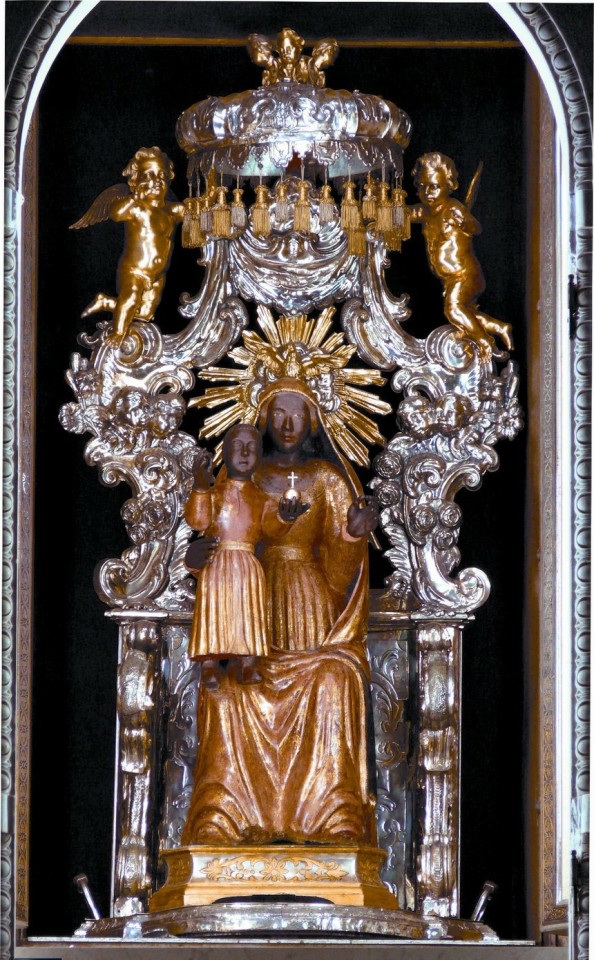




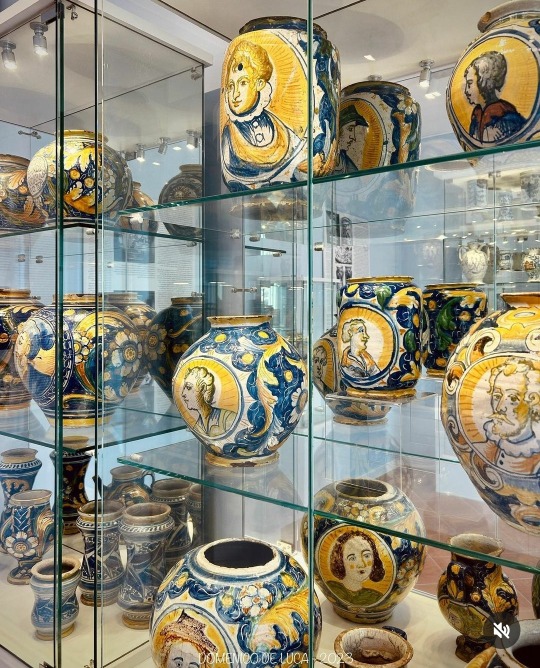
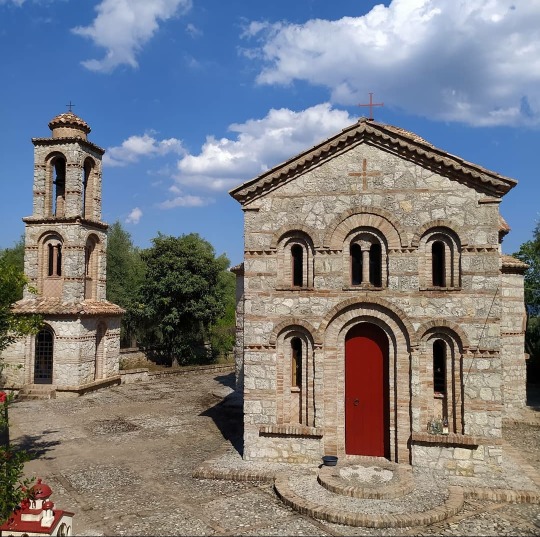
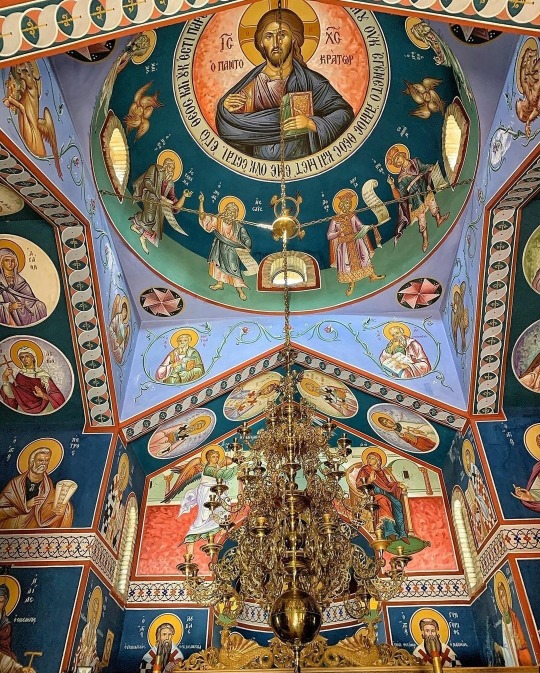
Seminara, Calabria, Italy
Seminara is located at the tip of the Italian boot about 30 kilometers (19 miles) north of Reggio Calabria. Its noteworthy political past includes turn-of-the-15th-century battles associated with the Italian Wars and a 1535 visit by the Holy Roman Emperor Charles V, who entered Seminara in a triumphal cortege to celebrate his victory over the Ottomans in Tunis.
Historically, the town has also had a reputation for its fine olive oil and silk.
Its two most distinguished citizens reflect southern Calabria’s Greek heritage, which endured long past the periods of Greater Greece and the Early Middle Ages when Orthodox Churches were established throughout the territory. Barlaam of Seminara (1290-1348) was an influential Byzantine-Greek clergyman and philosopher, and Leonzio Pilato (died 1364) was the first to translate Homer’s Iliad and Odyssey into Latin. His translations were used by the likes of Petrarca and Boccaccio.
The sanctuary of Maria Santissima dei Poveri is the main place of worship in Seminara, a town in the city of Reggio Calabria. It is well known because it preserves the statue of the Madonna dei Poveri, known as the Greek Black Madonna of San Basilio Magno. It is the oldest wooden statue in Calabria, carved in cedar wood and covered in gold and with its 92 cm, it is the second tallest black Madonna in the world, after that of Verdelot, in France.
In Seminara there is also one of the most interesting Greek Orthodox monastery of Southern Italy. Founded in 9th century by Sant’Elia of Enna, a Sicilian monk who lived in asceticism in a nearby cave, the monastery was endowed with rich goods and privileges by the Byzantine emperor Leo VI the Wise, who appreciated its sanctity and wisdom.
The monastery soon became a center of spiritual and cultural radiation, attracting numerous disciples and pilgrims, including the famous Filareto l’Ortolano, who died there in the odor of sanctity.
Unfortunately, it duffered the historical vicissitudes of Calabria, including invasions, earthquakes and persecutions. In the 16th century, following the forced Latinization of the Southern Orthodox churches, the monastery was abandoned and fell into ruin. 9th century Greek Orthodox Monastery. It was restored in 2005 and is now open for pilgrims and travelers.
Photos by Calabria Straordinaria, @piervalentino_pierva, @karim.ayed.1976, @dmncdlc, @morgana_zeta, , @esplorando_dietro_casa e @giuliaeats
Follow us on Instagram, @calabria_mediterranea
#seminara#calabria#italy#italia#south italy#southern italy#mediterranean#architecture#art#sculpture#sculptures#black madonna#greek orthodox#orthodox christianity#religion#byzantine#history#italian#europe#greek#church#churches
29 notes
·
View notes
Text
Code Geass: Lelouch of the Rebellion, Emperor Lelouch —Aesthetic

Emperor Lelouch vi Britannia's Reign
At eighteen, Lelouch became the 99th Emperor of the Holy Britannian Empire. He abolishes all the oppressive laws and class systems of Britannia. Lelouch frees every colony, thereby abolishing the concept of "Numbers," and puts down all resistance to his goals. However, the benevolent acts are a smokescreen for his intention to take over the world, the Zero Requiem. Eventually, with no one left to oppose him, Lelouch becomes ruler of the world. Later, he arranges the public execution of the Black Knight leaders and the U.F.N. representatives. Suzaku, disguised as Zero, interrupts and kills Lelouch, the culmination of the Zero Requiem as they had planned. By directing all the hatred of the world onto him, Lelouch's death will serve to facilitate peace, while simultaneously redeeming his and Suzaku's sins by having them impose the greatest punishments on themselves: death for Lelouch who wishes for a tomorrow with his sister, life for Suzaku who wishes to atone for his sins through death. When Lelouch falls near Nunnally, she takes his hand and realizes he had sacrificed himself on purpose for her dream and world peace. Lelouch dies smiling in the arms of a crying Nunnally, saying he has destroyed the world and created it anew. Suzaku is left playing the role of Zero. In reality, Lelouch leaves the country, having faked his death to live out his immortal life with C.C. as the two are seen on a hay cart in the Japanese version. He gains the power of "Code" from his father, Charles, who got it from V.V. Lelouch was able to kill Charles since his Geass was fully evolved. But before doing that, he used his powers to transfer Charles's Code to him. Shortly before dying, Charles grabbed Lelouch's neck with his hand that bore the Code Geass brand. As such, the brand transfered to his neck, thus why he started wearing typical clothes beyond his school uniform, which conceal his neck.
#lelouch#lelouch vi britannia#lelouch lamperouge#emperor lelouch#anime#dark anime#thriller anime#supernatural#aesthetic#art#moodboard#kingcore#royalcore
11 notes
·
View notes